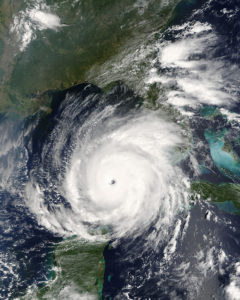Hurricane Rita
A Category 3 hurricane, Hurricane Rita made landfall twenty-six days after Hurricane Katrina.
This entry is 8th Grade level View Full Entry

Wikimedia Commons
Satellite View of Hurricane Rita.
Why is Hurricane Rita not as well known as other major hurricanes that have affected Louisiana?
New Orleans and the Mississippi Gulf Coast were devastated by Hurricane Katrina in August 2005. However, Katrina wasn’t the only hurricane to damage Louisiana that year. Hurricane Rita made landfall twenty-six days after Katrina and was the fourth-strongest Atlantic hurricane ever recorded. Rita flooded several communities across 250 miles of coastal Louisiana. Most of the homes and businesses in Cameron Parish were destroyed by Rita. For months residents of Grand Chenier, Creole, Cameron, Holly Beach, and Johnson’s Bayou were displaced. Several communities across Vermilion Parish and Terrebonne Parish, including the Native American settlement at Dulac, also were affected.
In the years that followed, residents complained of “Rita amnesia.” Residents believed that government agencies and the national media didn’t pay as much attention to the destruction caused by Rita as compared to Katrina. Some government officials and consultants suggested abandoning smaller communities and relocating residents away from flood zones. Local residents and Cajun culture champions opposed this suggestion.
How dangerous was Hurricane Rita?
The 2005 hurricane season was a remarkable one, unprecedented in both quantity and severity. Twenty-seven tropical storms and hurricanes formed in the North Atlantic Basin that year. The World Meteorological Organization ran out of names and had to use the Greek alphabet to identify the last six. By the end of the hurricane season, the Gulf region had endured seven major hurricanes. Hurricane Rita became the largest hurricane ever measured within the Gulf of Mexico at that time. It is one of the strongest Category 5 Atlantic hurricanes ever recorded. A crew of “hurricane hunters” from the Air Force Reserve measured one of its wind gusts at a remarkable 235 mph. It sparked the largest evacuation in American history when it appeared to be headed towards Houston, Texas.
Hurricane Rita made landfall near the Texas border on September 24 as a large Category 3 hurricane. It was so strong that it knocked out most of the weather buoys in its path before it reached shore. It also destroyed most of the homes and other buildings along the coast road, Louisiana 82. As a result of the thorough evacuation and the lack of high-water marks, eyewitness accounts, and weather gauge data, the National Hurricane Center couldn’t figure out Rita’s exact characteristics at landfall. It’s estimated that the storm had sustained winds of 120 mph, massive waves, and a fifteen-foot storm surge. In Cameron Parish, raging floodwaters swept away houses and dislodged more than 350 coffins from cemeteries and mausoleums. “I would use the word ‘destroyed,’ ” Army Lt. Gen. Russel Honoré, commander of US military relief operations in Louisiana, said of Cameron and Creole after his initial tour of southwestern Louisiana following Rita’s landfall. “Most of the houses and public buildings no longer exist.”
How destructive was Hurricane Rita?
In downtown Lake Charles, the storm surge flooded the Calcasieu River, destroying a dockside casino and badly damaging the lakefront civic center. The city’s airport terminal was destroyed by a tornado. Many homes were damaged by hurricane-force winds or fallen trees. Several small towns in Vermilion Parish were flooded, as were sugarcane fields, rice fields, and cattle ranches. In lower Vermilion Parish, storm surge washed tons of debris into sugarcane fields just weeks before harvest. Rice farmers in the area were especially affected by flooding because salt water overtopped levees surrounding the rice fields. Salt from the trapped gulf water seeped into the soil at toxic levels before farmers could break their levees and release the floodwaters. As a result many fields were ruined for up to three growing seasons.
Hurricane Rita caused massive destruction along the entire length of Louisiana’s southern coast. In the months and years of recovery that followed, though, residents were frustrated by the lack of attention paid to their needs compared to New Orleans’s needs after Hurricane Katrina. That difference had several causes. The area hit by Rita was less familiar to the national media than New Orleans, an international city with historical significance. Katrina killed 1,577 people in Louisiana; only one person died in Rita. The government response to the Katrina tragedy in New Orleans was widely criticized. It was difficult to assess the impact of Rita because the damage was spread out over many smaller, isolated communities.
As time passed, the Federal Emergency Management Agency (FEMA) funneled millions of dollars into the coastal parishes to fix infrastructure and rebuild schools. State government set up the Road Home program to help homeowners repair storm-damaged houses. Relief often came with the requirement that homeowners had to elevate their houses to new flood-resistant height standards imposed by the National Flood Insurance Program. The financial burden caused by that new regulation made returning to South Louisiana difficult, so many people voluntarily moved inland after Rita and follow-up flooding from Hurricane Ike three years later in 2008. As a result, the population of Cameron Parish was estimated by the US Census Bureau in 2012 to be 33 percent less than its pre-Rita population. Subsequent storms have further reduced the parish’s population. In 2020 the census showed 5,617 residents, down 56 percent from its pre-Rita population.
